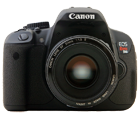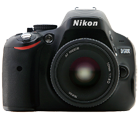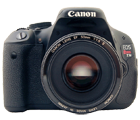Digital SLR Camera Crop Factor
Crop factor is a term that can cause a lot of confusion when you're trying to pick a digital SLR camera.
It doesn't help that it's referred to in several different ways. For example, all of the following mean the exact same thing:
- Camera Z has a 1.5 times crop factor
- Camera Z has a focal length multiplier of 1.5 times
- Camera Z has a 1.5 times lens focal length conversion factor
- A 50mm lens frames like a 75mm lens on Camera Z
The key thing to focus on is the multiplier: the three most common ones are 1.5, 1.6 and 2.0.
In a moment, I'll explain just what sort of multiplication is going on.
Digital Sensors vs. Film
It's easier to understand crop factor when you understand the difference in size between a digital SLR camera sensor and a standard 35mm film negative.
A digital SLR sensor is SMALLER than a standard frame of 35mm film.
|
Imagine that this circular image of a mountain is how the lens on your camera sees the world. In reality, the image captured by the lens is upside-down, but we'll ignore that for now. The large box is the size of a 35mm film negative. The smaller box is the size of a digital SLR sensor. |
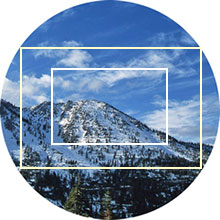 |
|
First you take the photo with a standard roll of film. The example to the right shows how much of the scene is captured on the 35mm film. The entire mountain is captured in this image. |
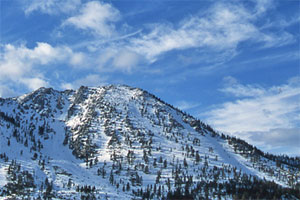 |
|
Here's how our digital SLR sensor sees the exact same scene, because the sensor is smaller than the 35mm film. Notice what happened? Large parts of the top and side of the photo are cut off, creating an artificial zoom effect. |
 |
If you stand in the same spot and take the same image with the same lens a digital SLR will capture less of the scene than a film SLR.
The digital SLR sensor has "cropped" the view - hence the term crop factor.
In order to capture the same view with your digital SLR, you have to step backwards — away from the scene you are photographing.
Crop Factor Multipliers
Time for a little bit of math...not much, I promise.
Let's go back to those crop factor multipliers that I mentioned at the top of the page.
Make sure you understand this point before going on: even though the smaller size sensor is cropping the image, the perceived effect is that you have zoomed closer to your subject.
This is why a lens that would otherwise be wide angle on a film camera becomes less so when attached to a digital SLR.
Example #1: 100mm Lens
When you attach a 100mm lens to a digital SLR camera with a 1.5x crop factor, it captures images more like a 150mm lens on a film SLR. [100mm x 1.5 = 150mm]
Let's work through this example for several more crop factors:
| Focal Length | Crop Factor | "Adjusted" Focal Length |
| 100mm | 1.6 | 160mm |
| 2.0 | 200mm |
Example #2: 28 to 75mm Zoom Lens
When you have a zoom lens, you just have to apply the multiplier to both ends of the zoom range:
| Crop Factor | Focal Length | "Adjusted" Focal Length |
| 1.5 | 28mm | 42mm |
| 75mm | 113mm | |
| 1.6 | 28mm | 45mm |
| 75mm | 120mm | |
| 2.0 | 28mm | 56mm |
| 75mm | 150mm |
Multipliers By Manufacturer
Here's some good news: every digital SLR camera doesn't have its own unique crop factor. Instead, the same crop factor applies to all the cameras from the same manufacturer.
Here are the manufacturer-specific crop factors:
| Manufacturer | Crop Factor |
| Canon | 1.6x |
| Nikon | 1.5x |
| Olympus | 2.0x |
| Pentax | 1.5x |
| Sony | 1.5x |
Is Crop Factor Bad?
Not necessarily. It depends on what type of photos you want to take:
- If you enjoy taking portraits, wildlife or macro photos then crop factor won't be an issue
- If you take landscape photos - or a lot of photos indoors - then crop factor will have an impact
Why is this?
Beautiful landscape photography leverages very wide-angle lenses to capture all of the scenery in front of the camera.
A lens with a focal length of 28mm is considered wide angle for a film SLR camera.
But a 28mm lens isn't wide angle when attached to a digital SLR.
This means that landscape enthusiasts have to use really wide angle lenses to capture those scenic vistas. 18mm and even 10mm lenses are not uncommon for dedicated digital landscape photographers.
When you research digital SLR camera packages, you'll notice that many kit lenses (the lens bundled with the camera) are 18-55mm, providing a good wide angle view.
Now you know why this is such a common choice when it comes to digital SLR kit lenses: crop factor is the culprit.
Full Frame SLRs
If you don't like the idea of having huge parts of your image cut off, then there is a solution: something called a full-frame digital SLR camera.
Full-frame digital SLRs have image sensors that are the same size as 35mm film. This means that they have no crop factor (or a focal length multiplier of one).
A 50mm lens on a full frame digital SLR captures the exact same field of view as a 50mm lens on a film SLR camera.
These types of cameras are great for semi-pro enthusiasts who want their lenses to capture the same image whether they are using a film SLR or digital SLR.
There's only one drawback: cost.
Full frame digital SLR cameras cost significantly more than their crop factor cousins, sometimes double the amount for the camera body with no lens.
For die-hard photographers (especially landscape and interior) the extra expense is worth it to capture a wide angle view of the world.
Buyer Tip
Don't worry about crop factor if:
- You want to take lots of portrait, macro or wildlife photos
- You don't want to spend a fortune on your camera
Look for less crop factor if:
- You want to take lots of landscape or interior photos
| Digital SLR Home |

|

